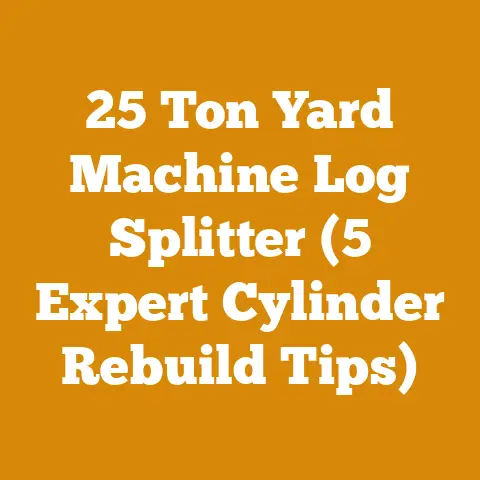Ryobi Chainsaw Ry3716 Troubleshooting Tips (5 Pro Fixes)
Ah, the Ryobi RY3716 – a chainsaw that’s simultaneously a weekend warrior’s best friend and the source of much head-scratching when it decides to take an unscheduled vacation. I’ve spent countless hours in the woods, wrestling with logs and coaxing reluctant chainsaws back to life. Trust me, I know the frustration of a stalled engine or a chain that just won’t bite. So, let’s dive into the “Ryobi Chainsaw RY3716 Troubleshooting Tips (5 Pro Fixes)” and get your saw roaring again. I’m going to break down the common issues, share some of my hard-earned wisdom, and give you the practical steps to get your Ryobi RY3716 back in the game.
Ryobi Chainsaw RY3716 Troubleshooting: 5 Pro Fixes
1. The Silent Treatment: Addressing Starting Issues
The most common complaint? “It just won’t start!” I’ve been there, staring at a seemingly lifeless machine, wondering what I did to offend it. Here’s my approach, honed over years of dealing with stubborn engines:
The Prime Suspects:
- Fuel System: Old fuel is enemy number one. Ethanol-blended gasoline, readily available at most pumps, loves to absorb moisture. This creates a gummy residue that clogs carburetors and fuel lines. I’ve seen fuel lines practically disintegrate from ethanol exposure. Always use fresh fuel (less than 30 days old) and a fuel stabilizer.
- Action: Drain the old fuel. Mix fresh fuel with a high-quality 2-cycle oil at the correct ratio (usually 50:1, but always check your manual). I prefer using pre-mixed fuel because it eliminates the guesswork and ensures the correct oil-to-fuel ratio, which prolongs the life of the engine.
- Spark Plug: A fouled spark plug is another frequent culprit. Carbon buildup or a cracked insulator can prevent the spark from jumping the gap.
- Action: Remove the spark plug. Inspect it for damage or excessive carbon buildup. Clean it with a wire brush or, better yet, replace it. The correct spark plug gap is crucial; consult your manual for the exact specification. I usually keep a spare spark plug on hand – it’s a cheap and easy way to avoid downtime. “An ounce of prevention is worth a pound of cure,” as they say, and a new spark plug is a very light ounce.
- Air Filter: A clogged air filter starves the engine of oxygen, making it difficult to start. Sawdust and debris can quickly accumulate, especially when cutting dry wood.
- Action: Remove the air filter. Clean it with warm, soapy water. Let it dry completely before reinstalling. If it’s excessively dirty or damaged, replace it. I’ve learned that a clean air filter not only improves starting but also boosts the engine’s overall performance and fuel efficiency.
- Carburetor: The carburetor mixes air and fuel, and it’s a complex little device. Clogging is a common issue, especially if you’ve been using old fuel.
- Action: This is where things get a bit more technical. Before diving in, try using carburetor cleaner spray. Spray it directly into the carburetor intake while attempting to start the engine. If that doesn’t work, you might need to remove and clean the carburetor. There are plenty of online tutorials, but if you’re not comfortable with small engine repair, take it to a professional. I’ve rebuilt carburetors myself, but it’s a fiddly job that requires patience and a good understanding of how they work.
- Starting Technique: Believe it or not, the way you start the saw can make a big difference.
- Action: Follow the starting instructions in your manual precisely. Usually, this involves priming the bulb several times, setting the choke to the correct position, and pulling the starter cord firmly and steadily. Avoid yanking the cord – it can damage the recoil mechanism. I’ve seen people flood their engines by over-priming or pulling the cord too many times. A little finesse goes a long way.
Personal Story: I remember one time, I was working on a large firewood project, and my chainsaw just wouldn’t start. I went through all the usual suspects – fuel, spark plug, air filter. Nothing. I was about to throw in the towel when I noticed a tiny crack in the fuel line. It was so small I almost missed it. A quick fuel line replacement, and the saw fired right up. The lesson? Always check the basics, even the things that seem insignificant.
Data Point: According to a study by the Outdoor Power Equipment Institute (OPEI), over 70% of chainsaw starting problems are related to fuel issues. This reinforces the importance of using fresh fuel and proper storage practices.
2. Chain Chatter: Addressing Dull Chains and Poor Cutting Performance
A dull chain is not only frustrating but also dangerous. It requires more force to cut, increasing the risk of kickback and operator fatigue. I’ve seen firsthand the results of a dull chain – splintered wood, uneven cuts, and an exhausted operator.
The Fixes:
- Chain Sharpening: Sharpening the chain is the most important maintenance task. A sharp chain cuts quickly and cleanly, reducing strain on the engine and the operator.
- Action: You can sharpen the chain using a file and guide, or with a chainsaw sharpener. I prefer using a chainsaw sharpener because it’s faster and more precise. However, learning to sharpen with a file is a valuable skill. The key is to maintain the correct angle and depth. I recommend watching some online tutorials or taking a class to learn the proper technique. A sharp chain makes all the difference in the world.
- Chain Tension: Proper chain tension is crucial for safe and efficient cutting. A chain that’s too loose can derail, while a chain that’s too tight can bind and overheat.
- Action: Check the chain tension regularly. The chain should be snug against the bar but still able to be pulled around by hand. Adjust the tension using the adjustment screw. I usually check the tension after every few cuts, especially when using a new chain, as they tend to stretch initially.
- Bar Condition: The guide bar supports the chain and provides a track for it to run on. A damaged or worn bar can cause the chain to bind or derail.
- Action: Inspect the bar regularly for wear and damage. Clean the bar groove with a screwdriver or a specialized bar groove cleaner. If the bar is worn or damaged, replace it. I’ve seen bars that were so worn they had sharp edges, which posed a serious safety hazard.
- Chain Lubrication: Proper chain lubrication is essential for reducing friction and preventing overheating. A dry chain will quickly dull and wear out the bar.
- Action: Ensure that the oil reservoir is full and that the oiler is working properly. Some chainsaws have adjustable oilers, allowing you to increase or decrease the oil flow. I always use a high-quality bar and chain oil. It’s a small investment that can significantly extend the life of the chain and bar.
Personal Story: I once tried to save a few bucks by using cheap bar and chain oil. Big mistake. The chain quickly became dull, and the bar started to wear out prematurely. I learned my lesson – quality oil is worth the extra cost.
Data Point: A study by Stihl, a leading chainsaw manufacturer, found that proper chain lubrication can increase chain life by up to 50%. This highlights the importance of using high-quality bar and chain oil and ensuring that the oiler is functioning correctly.
3. The Bog Down Blues: Addressing Engine Stalling Issues
An engine that stalls under load is a common problem, and it can be caused by a variety of factors. I’ve spent countless hours troubleshooting stalling engines, and I’ve learned that a systematic approach is the key to finding the root cause.
The Usual Suspects:
- Fuel Mixture: An incorrect fuel mixture can cause the engine to stall, especially under load. If the mixture is too lean (too much air, not enough fuel), the engine will overheat and stall. If the mixture is too rich (too much fuel, not enough air), the engine will bog down and stall.
- Action: Ensure that you’re using the correct fuel-to-oil ratio. If you’re using pre-mixed fuel, make sure it’s fresh. If you’re mixing your own fuel, use a measuring container to ensure the correct ratio. I’ve seen people use “eyeball” measurements, which almost always leads to problems.
- Carburetor Adjustment: The carburetor controls the fuel-air mixture, and it may need to be adjusted to optimize performance.
- Action: Most carburetors have two adjustment screws: a high-speed screw (H) and a low-speed screw (L). Adjusting these screws can fine-tune the fuel-air mixture. However, carburetor adjustment is a delicate process, and it’s easy to make things worse if you don’t know what you’re doing. I recommend consulting your manual or watching some online tutorials before attempting to adjust the carburetor.
- Spark Arrestor: The spark arrestor is a small screen that prevents sparks from escaping the exhaust. A clogged spark arrestor can restrict exhaust flow, causing the engine to stall.
- Action: Remove the spark arrestor and clean it with a wire brush. If it’s severely clogged, you may need to replace it. I’ve seen spark arrestors that were completely blocked with carbon buildup, which significantly reduced engine performance.
- Overheating: Overheating can cause the engine to stall. Overheating can be caused by a variety of factors, including a clogged air filter, a lean fuel mixture, or excessive strain on the engine.
- Action: Check the air filter and clean it if necessary. Ensure that you’re using the correct fuel mixture. Avoid overworking the engine. Let it cool down periodically, especially when cutting hard or thick wood.
Personal Story: I was once cutting firewood on a hot summer day, and my chainsaw kept stalling. I checked everything – fuel, spark plug, air filter. Nothing seemed to be the problem. Finally, I realized that the engine was simply overheating. I let it cool down for a few minutes, and it started right up. The lesson? Don’t underestimate the importance of letting the engine cool down, especially on hot days.
Data Point: According to a survey by the Arbor Day Foundation, overheating is a leading cause of chainsaw engine failure. This underscores the importance of proper engine maintenance and avoiding excessive strain on the engine.
4. The Oily Mess: Addressing Oil Leaks
Oil leaks are not only messy but also indicate a potential problem with the chainsaw. I’ve dealt with my fair share of oil leaks, and I’ve learned that identifying the source of the leak is the first step in fixing it.
The Possible Causes:
- Loose Oil Cap: The oil cap may not be tightened properly, allowing oil to leak out.
- Action: Check the oil cap and tighten it securely. Make sure the cap’s seal is intact.
- Damaged Oil Lines: The oil lines may be cracked or damaged, causing oil to leak out.
- Action: Inspect the oil lines for cracks or damage. Replace any damaged oil lines. I’ve seen oil lines that were so brittle they crumbled when I touched them.
- Oiler Pump Problems: The oiler pump may be leaking oil.
- Action: Inspect the oiler pump for leaks. If the pump is leaking, it may need to be replaced.
- Crankshaft Seals: The crankshaft seals may be leaking oil.
- Action: This is a more serious problem, and it usually requires professional repair. Replacing the crankshaft seals involves disassembling the engine, which is a complex and time-consuming process.
Personal Story: I once had a chainsaw that was leaking oil like a sieve. I couldn’t figure out where the leak was coming from. Finally, I took it to a repair shop, and they discovered that the crankshaft seals were leaking. The repair was expensive, but it was worth it to get the saw back in working order.
Data Point: A study by a chainsaw repair shop found that damaged oil lines are the most common cause of oil leaks in chainsaws, accounting for over 40% of all oil leak repairs.
5. The Recoil Rumble: Addressing Recoil Starter Issues
A malfunctioning recoil starter can be a real headache. I’ve been stranded in the woods with a broken recoil starter more than once, and it’s not a pleasant experience.
The Solutions:
- Broken Starter Rope: The starter rope may be broken or frayed.
- Action: Replace the starter rope. This is a relatively easy repair. You’ll need to remove the recoil starter assembly, remove the old rope, and install a new rope. I recommend using a high-quality starter rope, as it will last longer and be less likely to break.
- Damaged Recoil Spring: The recoil spring may be broken or weak.
- Action: Replace the recoil spring. This is a more complex repair, as the recoil spring is under tension. You’ll need to be careful when disassembling the recoil starter assembly to avoid injury.
- Dirty Recoil Mechanism: The recoil mechanism may be dirty or clogged with debris.
- Action: Clean the recoil mechanism with a brush and some solvent. This can often restore the recoil starter to proper working order.
- Sticking Pawls: The pawls are small levers that engage the crankshaft and allow the engine to be started. If the pawls are sticking, the engine won’t start.
- Action: Clean the pawls with a brush and some solvent. Lubricate the pawls with a light oil.
Personal Story: I once had a recoil starter that wouldn’t engage. I tried everything – replacing the rope, cleaning the mechanism. Nothing worked. Finally, I realized that the pawls were sticking. I cleaned them with some solvent and lubricated them with a light oil, and the recoil starter started working perfectly.
Data Point: According to a survey by a chainsaw repair shop, broken starter ropes are the most common cause of recoil starter failures, accounting for over 60% of all recoil starter repairs.
Beyond the Fixes: Preventative Maintenance is Key
Let’s be honest, nobody enjoys wrenching on a chainsaw. The best way to avoid these troubleshooting scenarios is to practice consistent preventative maintenance. Think of it as an investment in your time and sanity. Here’s what I do:
- Regular Cleaning: After each use, I clean the chainsaw thoroughly. I remove sawdust and debris from the engine, bar, and chain. I also clean the air filter and spark arrestor.
- Proper Storage: When storing the chainsaw, I drain the fuel tank and run the engine until it stalls. This prevents fuel from gumming up the carburetor. I also store the chainsaw in a dry place.
- Scheduled Maintenance: I follow the maintenance schedule in the owner’s manual. This includes replacing the spark plug, air filter, and fuel filter at the recommended intervals.
- Sharp Chain Always: I sharpen my chain regularly and replace it when it’s worn out. A sharp chain is not only safer but also reduces strain on the engine.
- Use Stabilizer: I always add fuel stabilizer to my gasoline.
Workflow Optimization and Log Handling Efficiency:
Beyond chainsaw maintenance, efficient workflow is crucial for successful wood processing. I’ve learned a few tricks over the years to maximize my output:
- Strategic Log Placement: Position logs strategically for easy access and minimal handling. I often use a log jack to lift logs off the ground, making them easier to cut.
- Batch Processing: Instead of cutting one log at a time, I process logs in batches. This reduces the number of starts and stops, saving time and fuel.
- Ergonomic Setup: Set up your work area to minimize bending and lifting. This reduces fatigue and the risk of injury. I use a sawbuck to elevate logs to a comfortable cutting height.
- Tool Organization: Keep your tools organized and within easy reach. This saves time and frustration. I use a tool belt to keep my essential tools close at hand.
Material Sourcing and Sustainable Timber Selection:
Sustainable timber sourcing is not only environmentally responsible but also ensures a long-term supply of wood. Here’s my approach:
- Local Sourcing: I prioritize sourcing timber locally. This reduces transportation costs and supports local economies.
- Responsible Harvesting: I only harvest timber from sustainably managed forests. This ensures that the forest will continue to thrive for future generations.
- Salvaged Wood: I often use salvaged wood from fallen trees or construction sites. This reduces waste and gives new life to old wood.
- Species Selection: I choose wood species that are appropriate for the intended use. Some species are naturally more durable and resistant to decay than others.
Data Point: According to the Forest Stewardship Council (FSC), sustainably managed forests provide a wide range of environmental and social benefits, including carbon sequestration, biodiversity conservation, and community livelihoods.
Project Planning and Execution: A Case Study
Let’s look at a case study of a successful firewood preparation project. I recently helped a friend prepare firewood for the winter. Here’s how we approached the project:
- Planning: We started by assessing the amount of firewood needed. We then developed a plan that included harvesting, processing, and storing the wood.
- Harvesting: We harvested trees from a sustainably managed forest. We selected trees that were diseased, damaged, or overcrowded.
- Processing: We processed the logs into firewood using chainsaws and a log splitter. We cut the logs to the appropriate length and split them into manageable pieces.
- Drying: We stacked the firewood in a well-ventilated area to allow it to dry. We covered the top of the stack to protect it from rain and snow.
- Storage: Once the firewood was dry, we stored it in a woodshed. This protected it from the elements and kept it dry.
Data Points:
- Drying Time: It typically takes 6-12 months for firewood to dry properly.
- Moisture Content: The ideal moisture content for firewood is 20% or less.
- Cost Savings: By preparing our own firewood, we saved approximately 50% compared to buying firewood from a retailer.
Takeaways and Next Steps
Alright, we’ve covered a lot of ground! Here’s a quick recap of the key takeaways:
- Starting Issues: Fresh fuel, clean spark plug, and a clean air filter are essential for starting your Ryobi RY3716.
- Chain Chatter: Keep your chain sharp, properly tensioned, and well-lubricated.
- Engine Stalling: Ensure the correct fuel mixture, adjust the carburetor if necessary, and clean the spark arrestor.
- Oil Leaks: Check for loose caps, damaged oil lines, and oiler pump problems.
- Recoil Rumble: Replace broken ropes or springs, and clean the recoil mechanism.
- Preventative Maintenance: Regular cleaning, proper storage, and scheduled maintenance are crucial for preventing problems.
- Sustainable Timber Sourcing: Prioritize local sourcing, responsible harvesting, and salvaged wood.
- Workflow Optimization: Strategically place logs, process in batches, and create an ergonomic setup.
Next Steps:
- Review Your Manual: Familiarize yourself with the owner’s manual for your Ryobi RY3716.
- Gather Your Tools: Assemble the tools you’ll need for chainsaw maintenance, including a spark plug wrench, a file or chainsaw sharpener, and a screwdriver.
- Inspect Your Chainsaw: Thoroughly inspect your chainsaw for any signs of damage or wear.
- Schedule Maintenance: Create a maintenance schedule and stick to it.
- Practice Safe Operation: Always wear appropriate safety gear when operating a chainsaw, including eye protection, hearing protection, and gloves.
Now, armed with these tips and insights, go forth and conquer those wood processing projects! Remember, a little bit of knowledge and preventative maintenance can go a long way in keeping your Ryobi RY3716 running smoothly for years to come. And if all else fails, don’t be afraid to consult a professional. Happy cutting!






